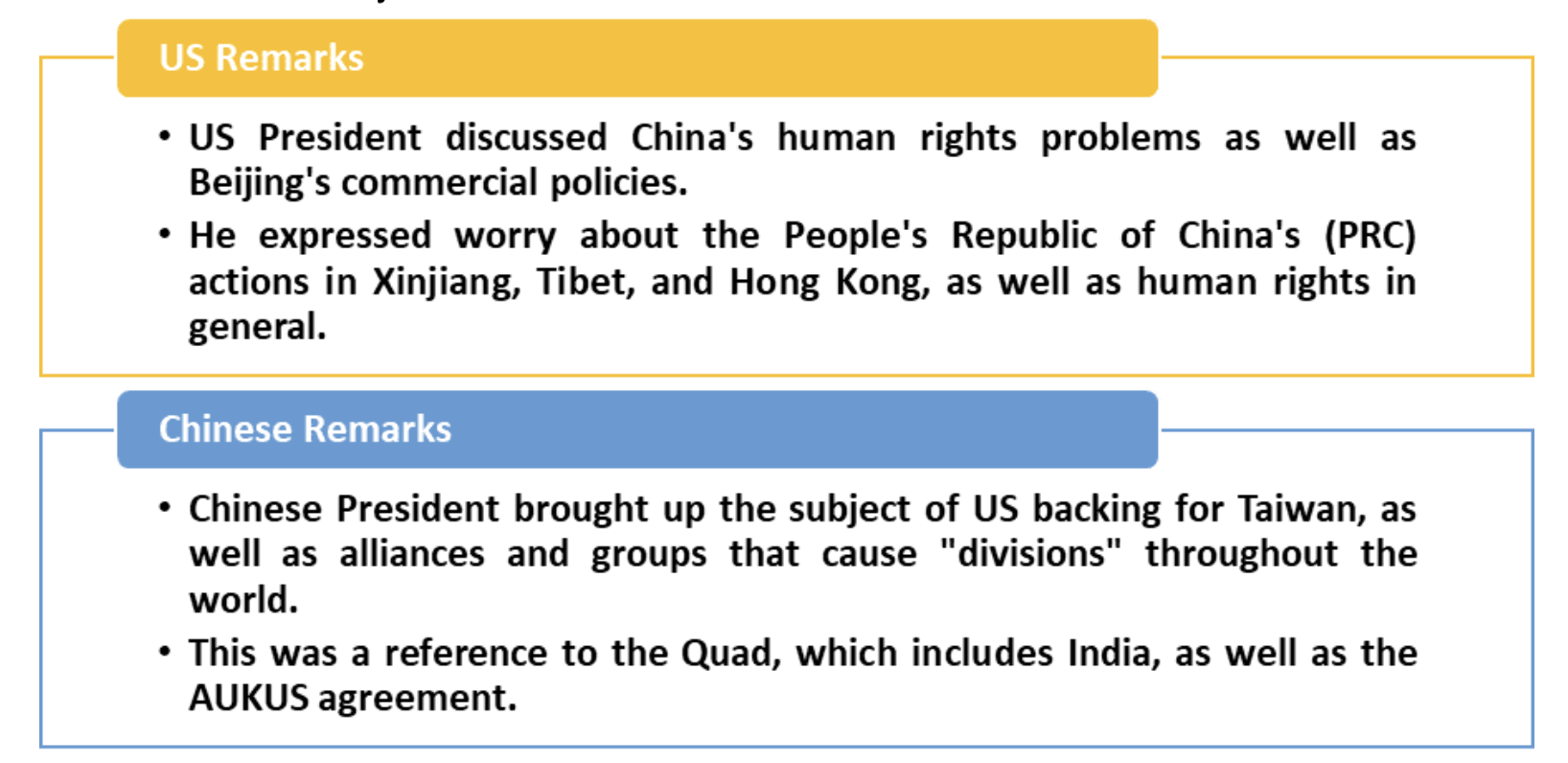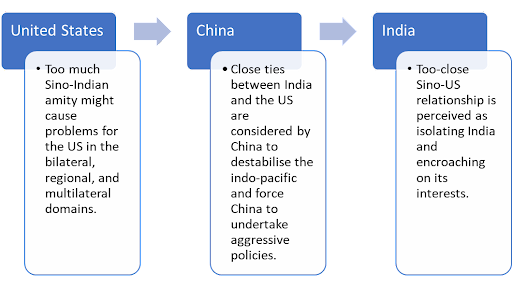International relations is a very important segment of the UPSC syllabus. In this series, we present an analysis of the most important international issues and developments that occurred over the past week relevant for the IAS exam. In this article, you can learn more about the Biden-Xi Virtual Summit and related developments.

Biden-Xi Virtual Summit
- Introduction
- President Joe Biden of the United States and his Chinese counterpart Xi Jinping recently conducted a virtual summit to discuss a variety of bilateral policy issues.
- The US President took the initiative to convene the meeting, reflecting America’s desire to avoid military conflict with China.

- Background of Biden-Xi Virtual Summit:
- The two leaders’ video conference meeting comes at a time when tensions are at an all-time high.
- There is rising concern that a conflict would erupt over Taiwan’s fate and freedom of passage in the South China Sea.
- The summit takes place amid a background of international indignation over China’s treatment of its Uyghur Muslim community and Hong Kong, as well as a surge in cyber-attacks blamed on China by the US.
- There are also fundamental disagreements on what each country should do to address the climate disaster, and the United States is becoming increasingly concerned about China’s fast development of conventional and nuclear armed forces.
- Meanwhile, tensions between Washington and Beijing have risen on a number of other global and regional issues, including trade, as well as technology, such as 5G.
Significant Keywords used by US-China
- The US President said he hoped the two men would have a candid and forthright discussion “like all of the discussions we’ve had thus far”, and establish “rules of the road” for their future behaviour.
- “It seems to be our responsibility, as leaders of China and the United States, to ensure that the competition between our countries does not veer into conflict, whether intended or unintended,” Biden said, saying the two nations should pursue “just simple, straightforward competition.”
- According to Chinese state media, Xi told Biden the earth was big enough for the development of both China and the US, and that leaders should not play zero-sum games.
- “Humanity lives in a global village and we face multiple challenges together,” the Chinese President said.
- “Common sense guardrails” seems to be the administration’s new mantra for managing the risk of conflict with China.
Critical Analysis of US-China Relations:
- Timeline of the U.S.-China Relations

Source: T. Rowe Price
- Concerns Associated with US China Ties:
- The US-China political tussles over China’s treatment of the Uighur population in Xinjiang, the destruction of democracy in Hong Kong, the PRC navy flexing its naval muscles in the South China Sea and the East China Sea are significant areas of concern.
- Besides, Chinese threats to annex Taiwan by military force, and a variety of other Chinese assertions have all strained relations between the two countries.
- China is facing domestic economic challenges such as real estate crisis, energy shortages, state-owned companies defaulting on debt payments, foreign investors leaving China, Indo-Pacific countries seeking alternative supply chains, China’s hidden debt of trillions of dollars, etc.
- So far, the US has been able to contain the damage of the “tariff” war with China, and has discovered that China is the relative loser.
- It is obvious that China has been providing a serious threat to the US in terms of foreign aid, developmental assistance, and foreign investments, notably through the Belt and Road Initiative.
- Furthermore, the US government lacks the constitutional authority and financial resources to compete with China’s Belt and Road Initiative.
- However, the United States’ greatest strength in global politics remains its leadership, alliances, strategic partnerships, and indisputable capacity to keep its security obligations.
Possibilities of Cooperation between US – China
- Cooperation between the United States and China is theoretically intended to serve two purposes in US–China relations.
- First, to cooperate in areas where the two nations’ interests ostensibly intersect. Global health, nuclear nonproliferation, counterterrorism, climate change mitigation, and worldwide economic development are among them.
- Second, to provide the relationship stability so that tensions arising from areas where the two authorities disagree may be alleviated.
- The US-China relationship now has five areas of cooperation: dealing with a pandemic, an economic crisis, calls for racial justice, science and technology and climate change.
- Confronting a Pandemic: When it comes to the coronavirus pandemic, the two countries might work together to improve diagnostic and treatment experience, personal protective equipment manufacture, and vaccine research, manufacturing, and distribution.
- Climate Change: At the COP26 climate meeting in Glasgow, China and the United States agreed to increase climate cooperation over the next decade. Both nations’ macroeconomic conversations must be strengthened, and China is willing to coordinate policies, implying a return of two-way strategic discussions on climate change. Strategic collaboration on themes such as technology, electric cars, and electrolyzers that produce hydrogen, as well as fuels for a sustainable energy future, is a step in the right direction.
- Science and Technology: The U.S.-China Clean Energy Research Center (CERC) is a classic example of the advantages of government-sponsored technology collaboration. The United States and China must strengthen bilateral agreements that address urgent concerns such as intellectual property protection. Both nations must identify and leverage on existing partnerships in sectors such as 5G, cyber security, space programmes, renewable energy, digital healthcare, and so on.
- Economic Development : Trade between China and the United States is “mutually beneficial in nature.” The two sides must remove artificial impediments and set positive expectations for the successful growth of bilateral economic and commercial cooperation.” The emphasis should be on adopting efforts at home and with partners overseas to improve America’s long-term competitiveness in relation to China.
- Calls for Racial Justice: China has used the death of George Floyd at the hands of Minneapolis police, the Black Lives Matter (BLM) movement, and ongoing protests across the United States to highlight America’s failure to protect its citizens and live up to its claims of racial equality and social justice, as well as to deflect criticism over Beijing’s brutal suppression of dissent in Hong Kong. In light of the ‘New Normal’ in China-US ties, both nations should cooperate to promote racial equality.
Geopolitical Aspects of US-China Relations

Source: T. Rowe Price.
- Tensions in Indo-Pacific:
-
- Over the past few months, China has increased its maritime activity in both the South China Sea and the East China Sea, partially in reaction to Beijing’s concerns over the region’s growing US military presence as a result of mounting Sino-US tensions.
- Japan and US-China
-
- The US-Japan alliance is no longer the sole significant partnership for the US in the Asia-Pacific area. On the other hand, as the agenda for US-China collaboration on shared difficulties increases, Tokyo’s fears that Japan’s interests would be sacrificed in Washington for the sake of US-China relations will certainly grow.
- China has five concerns about Japan-China relations: a strengthened US-Japan alliance, which China sees as a mutual deterrent against China; Japan’s more proactive stance in the South China Sea, especially with US support; Japan’s relationship with Taiwan; Japan’s maritime rule-of-law campaign; and historical issues and a lack of public trust.
- Furthermore, tensions between Japan and China have risen over the disputed Senkaku islands in the East China Sea.
- Russia and US-China
-
- The United States and China have quite different attitudes about Russia. China and Russia want to be good neighbours and partners because they are both concerned with properly managing and rejuvenating their own nations and want a safe international environment.
- China and Russia’s conflicts with the United States and its allies have aided collaboration, but they have their own historical disagreements, such as China’s supremacy.
- Relations between the United States and Russia have lately become extremely strained, with sanctions and counter-sanctions ballooning out of control.
- The Biden administration appears to be harder on Russia yet also powerless in the face of a strong and resolute Putin.
- Complexity in Europe’s Relationship With China
-
- China’s strong foreign policy, as well as its breaches of international legal commitments and severe human rights violations in Hong Kong and Xinjiang, are causing growing worry in the EU.
- The greatest issue is that Chinese investments in vital industries can lead to economic reliance, particularly among smaller nations and economies in transition, and that this connection might spill over into politics.
- South Korea and US-China
-
- South Korea is one of the few Asian countries with long-standing historical links to China as well as a vital partnership with the United States.
- As the US-China competition heats up and spills over into trade and technology policy, this two-sided reality puts enormous strain on Seoul.
Areas of Concern in US-China Relations:
- Taiwan: China maintains the right to “unify” Taiwan with the Mainland by force. If force is employed to annex Taiwan, the US will stand firm in its resolve to interfere. As a result, Taiwan remains a possible hotspot for military war between China and the United States.
- Tussle for Influence: The US and China have fundamentally different views on how people and economy should be managed. On land, in outer space, and in cyberspace, the two powers struggle for influence beyond their own boundaries, compete in technology, and manoeuvre for military advantages.
- Military Alliances: As China’s military presence in the area has grown, the Biden administration has pushed to expand America’s military alliances with Australia, Japan, India, and other countries. Such moves are seen in Beijing as a deadly provocation aimed at securing American “hegemony.”
- Strength in Commerce: The Trump administration’s trade war has been put on hold for the time being. However, the Biden campaign has continued to criticise China’s economic policies, particularly Beijing’s massive backing for steel, solar cells, computer chips, and other domestic industries, which prompted Mr. Trump to impose tariffs on Chinese exports. Mr. Xi has declared that, under what he refers to as a “dual circulation” approach, China’s economy should be driven largely by local demand and indigenous innovation, with exports coming in second.
- Economic Nationalism: The current atmosphere of economic nationalism has sparked renewed interest in and investment in domestic brands. Foreign enterprises who do not toe the party’s line on Hong Kong, Tibet, and other hot-button topics, or are otherwise perceived as disrespectful to China, are more intolerant of Chinese customers.
- High-Tech Supremacy: Many other American technology businesses, like Apple, Tesla, Qualcomm, and Intel, continue to do well in China. This raises a slew of concerns in Washington, including allegations that Chinese agents are stealing the companies’ technology and secrets, that the products they manufacture in China are vulnerable to cyber espionage, and that they are compromising their professed values in order to play by Beijing’s rules.
- Human Rights and Freedoms: For decades, the Communist Party’s officials have reacted angrily to foreign criticisms of their totalitarian rule, labelling them as violations of national sovereignty. However, as Mr. Xi’s party has stepped up its repression of opposition, China’s clashes with the US over principles and freedoms have been more regular. Washington has sanctioned Chinese officials in reaction to Beijing’s harsh response to Hong Kong’s pro-democracy rallies in 2019.
- China’s Economic Strength Incentivises Broader Diplomacy: China’s importance in the global economy continues to grow, providing investors with a tremendous opportunity. The geopolitical climate, on the other hand, is both volatile and prone to escalation, necessitating long-term surveillance. Businesses operate against a backdrop of geopolitical risk, and typical operations can be more challenging to handle when ties are strained.
- Dependency on China: Faced with the threat of being cut off from or having limited access to American supply chains, Chinese officials have stepped up their efforts to diversify economic ties and increase self-sufficiency in recent years. They have also implemented measures that have encouraged other nations to become increasingly reliant on China for their own economic development.
- Chinese concerns over Quad: China sees the Quad as an example of US efforts in the Indo-Pacific area to build a political, economic, scientific, and military architecture that would support the fundamental US goal of competing with China and protecting America’s dominance.
- AUKUS Implications: The announcement of AUKUS, a significant nuclear-powered submarine deal for Australia, solidifies America’s strategic pivot toward China. The new agreement would allow Australia’s navy to monitor the South China Sea, the Taiwan Strait, and beyond, bolstering the US-led containment of China.
- U.S. Withdrawal From Afghanistan: The abrupt end to two decades of US military involvement in Afghanistan, as well as the rapid fall of the US-installed Kabul administration, followed by the Taliban’s control of the nation, has brought an end to an era in US foreign, defence, and security policy that started on September 11, 2001. The real decision attempted to reorient US geopolitical and military efforts away from the Middle East and terrorism and toward major power confrontation with China.
- Iran’s Accession to the SCO: The SCO began the process of admitting Iran to the organisation in September 2021, something that both Moscow and Beijing have long advocated. Because the SCO is not a military alliance or even a political coordination mechanism—which would be unthinkable with such diverse membership—participation of Iran does not imply the development of an anti-US bloc. Nonetheless, Iran’s admission to the SCO is another step toward the geopolitical consolidation of continental Asia, in which China and Russia are leading the way.
- Tensions over Taiwan and Ukraine issue: Concerns regarding the security and long-term viability of America’s two other exposed proxies, Taiwan and Ukraine, arose almost immediately after the US left Afghanistan. While tensions in both regions remain high, the US is taking a significant risk by confronting both Beijing and Moscow at the same time. The other two nations seek to keep their strategic flexibility by focusing only on their respective confrontations with the US.
Implications on India
- Confrontations between Trilateral Relationships:

- Concerns for India
- In the next few years, India may expect heated competition between the United States and China, which would actually foster a multipolar Indo-Pacific system.
- The major problem for India would be the Chinese government’s international misadventure in invoking nationalism at home in order to conceal its internal failings.
- For more than a year and a half, India and China have been trapped in a border stalemate; India is a member of the Quad, and its strategic alignment with the US has been very obvious and unequivocal.
- China has been considered as a geopolitical adversary by both Trump and Biden administrations.
- There is anxiety about the US’s trustworthiness, with the fear that the US may choose China over India due to the increasingly interdependent Sino-American economic connection and/or abandon India.
- This feeling of uncertainty and lack of trust in the other side’s future duties and security policies has resulted in a hedging policy with an inbuilt unwillingness to establish an agreement or even a limited geopolitical understanding.
- Recent Chinese blunders, statements, and aggressions have sparked worldwide outrage. India, Japan, Australia, and the United States have created a Quad forum, and India, Japan, and Australia have agreed to build alternate supply routes for continuous commerce in the Indo-Pacific.
To know about the basic overview of India’s Foreign Policy, visit the linked article.
- Recommendations for India
- India and the United States should continue to enhance their broader ties, including interactions with China, to show the benefits of collaboration.
- China’s imperatives should be balanced, thus the two nations should continue to discuss.
- The United States should continue to back India’s efforts to strengthen ties with its friends and neighbours in Southeast Asia.
- India, on the other hand, must demonstrate that it can walk the talk and implement its “Act East” strategy, which aims to strengthen both strategic and commercial ties with the area.
- An official China-India-United States trilateral dialogue should also be considered, as it could serve at least two purposes: provide a platform for discussing issues of mutual concern and demonstrate to Beijing that India and the United States are not interested in excluding it if it is willing to participate in the solution.
Way Forward
- Both countries should acknowledge the importance of ‘practical, results-oriented interactions’ in bilateral relations.
- Concrete rather than symbolic acts should be the emphasis of future joint endeavours. In diplomacy, symbolism can be beneficial, but over the next several years, the focus will be on delivering concrete results. The watchword should be compartmentalization rather than connection.
- When feasible, multilateral mechanisms should be used to carry out joint actions. Working via these channels will have the strategic benefit of signalling to third parties that the US is not looking for all-out war.
- Prioritizing international approaches would also compel China to bear diplomatic costs with a number of nations, not just the US, if it decides to withdraw from a deal. It would lower the internal political costs of attempting to collaborate in the first place in both Washington and Beijing.
- The primary exception to the multilateral preference is security programmes to decrease risk and enhance crisis management, which are still worth pursuing bilaterally.
Read more International Relations This Week articles in the link.
International Relations This Week – Biden-Xi Virtual Summit and Other Issues:- Download PDF Here
| Related Links | |||
| Environment Questions for UPSC Mains GS 3 | Topic-Wise GS 3 Questions for UPSC Mains | ||
| Kyoto Protocol | List of Environment Conventions & Protocols | ||
| UNFCCC COP24 | UNFCCC COP25 | ||
Comments